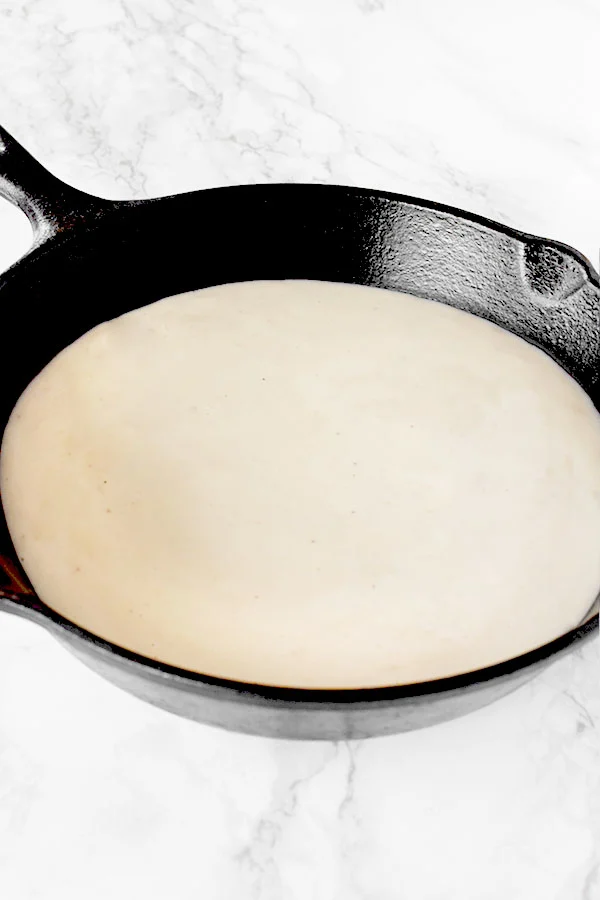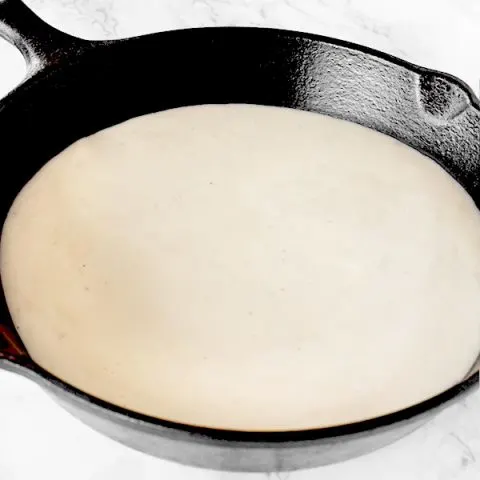This Gluten Free Béchamel Sauce or White Sauce is a dairy free version of the French classic sauce and is a key ingredient for many dishes.

Gluten Free Béchamel Sauce or White Sauce is a must for dishes such as Gluten Free Scalloped Potatoes.
The French term for this medium-thick white sauce is béchamel and it is important as a base for soufflés.
Typically, this sauce is made with a roux.
However, since a roux is flour and fat cooked together until it reaches a specific color, it is not gluten free friendly.
So, this recipe uses a slurry instead.
Slurries are commonly used in Asian cooking and Chinese-American cuisine. It is used to make sauces needed for recipes like Beef Broccoli and Pepper Steak.
A slurry, like a roux, is used to thicken gravies, sauces, stews, and soups. However, unlike a roux, it is added at the end of the recipe.
It is a combination between corn starch or potato starch and water and provides a silky texture.
While it is less common, slurries can be made out of flour, but obviously we won't be doing that here.
Both cornstarch and potato starch can be used to make sauces and gravy.
However, just like a roux, using a slurry helps avoid clumping. In fact, it does so even more easily.
CORNSTARCH VS CORNFLOUR
Cornstarch and cornflour are the same thing. In North America, cornstarch is the term commonly used, whereas in Europe it is referred to as cornflour.
POTATO STARCH AND OTHER STARCHES
This recipe calls for cornstarch just because it is the most common. However, you can use potato starch or any other starch you have on hand.
POTATO STARCH VS POTATO FLOUR
Potato flour is made from whole peeled potatoes, cooked, dried, and ground into a fine, beige-colored powder.
Potato starch, on the other hand, is “washed” out of crushed potatoes, then dried to a fine, bright-white powder.
Potato flour is great for adding moisture and flavor to breads, while potato starch is the right choice for sauces and gravies.
Cornstarch
Starch is a natural component of almost all grains and some fruits and vegetables.
One of starch’s compelling properties is its ability to absorb and retain lots of liquid.
Starches are incredibly versatile ingredients. They cause the liquid to thicken and add moisture as well as a tender and delicate texture in baked goods.
They can also be combined with water as an egg replacement for eggless and vegan recipes, working as a binder and to add moisture.
In addition, starches are sometimes used to make a coating for frying, which creates a crispy texture on fried foods like fried chicken.
It's also not uncommon to find starch used as a stabilizer.
Cornstarch is one of the most versatile starches there are. It is a terrific ingredient for thickening sauces, puddings, soups, and pie fillings and is also used in many baked good recipes.
Cornstarch Uses
Cornstarch is an underrated and underused ingredient in home kitchens. Here are a number of ways cornstarch can be used:
Cornstarch for thickening soups, stews, and gravies
Cornstarch is often used as a thickening agent when added to soups, stews, and gravies.
This is usually done by making a slurry which is then added to whatever is in need of thickening.
Cornstarch in baked goods
Starch helps keep breads, cakes, quick breads, muffins, cupcakes, and brownies fresh by absorbing and holding liquid.
For breads, you can replace up to ¼ cup of all-purpose flour with cornstarch out of every three cups of flour.
For cakes, quick breads, muffins, and cupcakes, you can replace 2 tablespoons out of every cup of all-purpose flour.
Cornstarch in Cookies
Cornstarch gives cookies a soft center, helps prevent them from spreading, and adds chewiness.
Add ½ to 1 teaspoon of cornstarch per cup of flour called for in the recipe.
Cornstarch for Chewy Brownies
For chewy brownies that taste like those from the box, add 1 tablespoon of cornstarch per ½ cup of flour.
How to substitute Cornstarch
Cornstarch is one of a number of starches available - though it tends to be the easiest to find.
The best alternative to cornstarch in my opinion is potato starch.
You should substitute potato starch for cornstarch in a 1:1 ratio. This means if you need 1 tablespoon of cornstarch, use 1 tablespoon of potato starch instead.
Which dairy free milk should I use?
Honestly, it's whatever you have on hand or prefer.
My go-to is a neutral flavored full fat oat milk because I find that they are the most similar to regular full fat milk.
Almond milk works well here, too. I personally like using an unsweetened barista almond milk because it is more similar to regular full fat milk, but whatever you have will work.
You can also use coconut milk, though it may have a subtle coconut flavor if you do. Coconut milk has more fat and is similar to using a light cream, but it won't make a noticeable difference.
I've never used soy milk, so I don't have any opinions on it, but you can use that as well.
CAN IT BE MADE AHEAD OF TIME?
Yes. You can make this gravy a day or two before and simply reheat it shortly before you’re ready to serve.
Let sauce cool completely, cover it with wax paper or pour a film of milk over it to prevent a skin from forming.
Does bechamel sauce have gluten?
Yes. Bechamel sauce is usually made with wheat flour. However, this recipe uses potato starch or cornstarch.
Are Bechamel sauce and Alfredo sauce the same?
No, Bechamel sauce and Alfredo sauce are two different sauces. Alfredo sauce includes cheese and heavy cream.
HOW TO STORE
Once the sauce has cooled, place it in an airtight container. Keep up to 5 days in the refrigerator.
HOW TO FREEZE
Once the sauce has cooled, place it in an airtight container or a resealable freezer bag.
You can freeze sauce for up to 5 months. After that, it is still safe to eat, but the quality begins to degrade.
How to Reheat
Gravy will thicken as it cools. When you reheat it, add dairy free milk or water until it is smooth and reaches your desired consistency again.
Béchamel Sauce or White Sauce with Cornstarch

Gluten free béchamel sauce or white sauce made without flour. Perfect for scalloped potatoes and other classics.
Ingredients
- 2 tablespoons potato starch or cornstarch
- 2 tablespoons water
- 1 ¼ cups milk or dairy free milk, heated
- Salt and freshly ground pepper to taste
Instructions
- In a cup, slowly mix water into the cornstarch until smooth to make a slurry.
- Heat milk or dairy free milk in a sauce pan.
- Once warm, whisk in the slurry.
- Continue cooking and stirring until thick.
- Add salt and freshly ground pepper to taste.
Notes
If the gravy becomes too thick, you can thin it out with a little more water or dairy free milk.
Nutrition Information:
Yield:
1Serving Size:
1Amount Per Serving: Calories: 398Total Fat: 11gSaturated Fat: 7gTrans Fat: 0gUnsaturated Fat: 4gCholesterol: 44mgSodium: 597mgCarbohydrates: 55gFiber: 2gSugar: 1gProtein: 21g
kameljoe21
Friday 23rd of February 2024
I am going to try this with 2 tbsp corn starch and 1 cup whole milk. This will half the calories from my standard bechamel sauce of 3 tbsp flour, 3 tbsp butter spread, 1 cup whole milk which was about 400 calories. Using corn starch will nearly half it. This should make souffles a bit less calories with out changing their overall texture/taste.
Barb House
Sunday 9th of April 2023
That was perfect and so much easier than traditional white sauce using a roux.
ElissaBeth
Thursday 13th of April 2023
I am glad you found it so :)